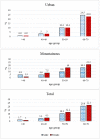Prevalence of self-reported coronary heart disease and its associated risk factors in Tabari cohort population
- PMID: 32429905
- PMCID: PMC7236270
- DOI: 10.1186/s12872-020-01526-w
Prevalence of self-reported coronary heart disease and its associated risk factors in Tabari cohort population
Abstract
Background: Prevalence of coronary heart disease (CHD) risk factors are increasing in developing countries. The present study aimed to assess the prevalence of self-reported CHD and evaluate the role of various risk factors on its prevalence in the Tabari cohort study (TCS) population.
Methods: The enrollment phase of TCS was performed between June 2015 and November 2017. In the current study, data were derived from information collecting from the enrollment phase of TCS. In the enrollment phase, 10,255 individuals aged 35-70 living in urban and mountainous areas of Sari (northern part of Iran) were entered into the study. Educational level, socioeconomic and marital status, history of smoking, opium and alcohol abuse/addiction, level of daily physical activity, indices of obesity, and traditional risk factors of the participants were determined.
Results: The prevalence of CHD was measured at 9.2%. Older individuals (P<0.001), people with a body mass index≥30kg/m2 (P<0.001), diabetics (P<0.001), and hypertensive (P<0.001) have been shown to have an increased risk for CHD compared with participants of without CHD. Furthermore, the CHD was more prevalent in individuals with higher waist circumference (P<0.001), higher low-density lipoprotein cholesterol (P<0.001), lower high-density lipoprotein cholesterol (P<0.001), and a higher waist to hip ratio (P<0.001). In addition, individuals with low socioeconomic status, illiterate people, and opium users had a higher prevalence of CHD (P<0.001). The results of the multivariable logistic regression analysis showed that the probability of CHD among individuals who had 8-10 risk factors was estimated at 8.41 (95% confidence interval: 5.75-12.31) times higher than those with less than 3 risk factors.
Conclusion: According to the results of the present study, it seems that the prevalence of CHD in the Iranian population is relatively high.
Keywords: Cardiovascular disease; Low and middle-income countries; Prevalence; Risk factors.
Conflict of interest statement
The authors declare that there is no conflict of interest.
Figures
Similar articles
-
Prevalence of anemia and related factors among Tabari cohort population: a cross-sectional study.BMC Public Health. 2024 Oct 3;24(1):2702. doi: 10.1186/s12889-024-20220-6. BMC Public Health. 2024. PMID: 39363176 Free PMC article.
-
Tabari Cohort Profile and Preliminary Results in Urban Areas and Mountainous Regions of Mazandaran, Iran.Arch Iran Med. 2019 Jun 1;22(6):279-285. Arch Iran Med. 2019. PMID: 31356093
-
The frequency of asthma and its related factors: results of the enrolment phase of Tabari cohort study.J Asthma. 2024 Oct;61(10):1275-1283. doi: 10.1080/02770903.2024.2337850. Epub 2024 Apr 10. J Asthma. 2024. PMID: 38551851
-
Risk factors for coronary heart disease in women.Cardiol Clin. 1998 Feb;16(1):1-8. doi: 10.1016/s0733-8651(05)70378-7. Cardiol Clin. 1998. PMID: 9507775 Review.
-
Prevalence of obesity, central obesity and the associated factors in urban population aged 20-70 years, in the north of Iran: a population-based study and regression approach.Obes Rev. 2007 Jan;8(1):3-10. doi: 10.1111/j.1467-789X.2006.00235.x. Obes Rev. 2007. PMID: 17212790 Review.
Cited by
-
The prevalence and predictors of cardiovascular diseases in Kherameh cohort study: a population-based study on 10,663 people in southern Iran.BMC Cardiovasc Disord. 2022 May 28;22(1):244. doi: 10.1186/s12872-022-02683-w. BMC Cardiovasc Disord. 2022. PMID: 35643460 Free PMC article.
-
Prevalence and associated factors of self-reported ischaemic heart disease and/or stroke: a cross-sectional nationally representative community-based study of adults in Malawi in 2017.BMJ Open. 2021 Sep 23;11(9):e048167. doi: 10.1136/bmjopen-2020-048167. BMJ Open. 2021. PMID: 34556509 Free PMC article.
-
Patterns of risk factors for cardiovascular diseases in Kheramah PERSION cohort population using a latent class analysis.Sci Rep. 2025 Jul 8;15(1):24496. doi: 10.1038/s41598-025-08334-2. Sci Rep. 2025. PMID: 40628821 Free PMC article.
-
Prevalence and Correlates of Self-Reported Cardiovascular Diseases Among a Nationally Representative Population-Based Sample of Adults in Ecuador in 2018.Vasc Health Risk Manag. 2021 May 4;17:195-202. doi: 10.2147/VHRM.S299272. eCollection 2021. Vasc Health Risk Manag. 2021. PMID: 33976550 Free PMC article.
-
Circulating brain-derived neurotrophic factor dysregulation and its linkage with lipid level, stenosis degree, and inflammatory cytokines in coronary heart disease.J Clin Lab Anal. 2022 Jul;36(7):e24546. doi: 10.1002/jcla.24546. Epub 2022 Jun 6. J Clin Lab Anal. 2022. PMID: 35666604 Free PMC article.
References
-
- Joshi R, Jan S, Wu Y, MacMahon S. Global inequalities in access to cardiovascular health care: our greatest challenge. J Am College Cardiol. 2008;52(23):1817–1825. - PubMed
-
- Gersh BJ, Sliwa K, Mayosi BM, Yusuf S. Novel therapeutic concepts the epidemic of cardiovascular disease in the developing world: global implications. Eur Heart J. 2010;31(6):642–648. - PubMed
Publication types
MeSH terms
Grants and funding
LinkOut - more resources
Full Text Sources


